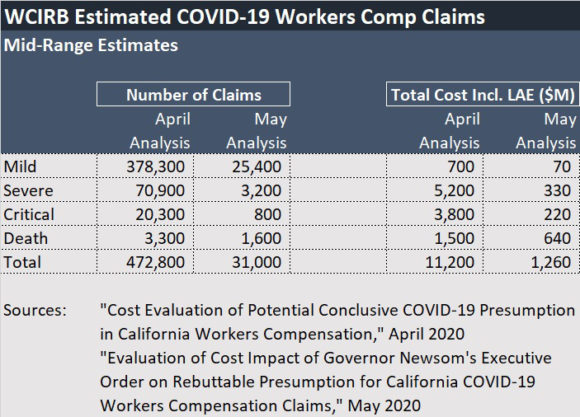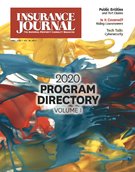The Workers’ Compensation Insurance Rating Bureau of California published estimated costs of allowing state workers to receive benefits for COVID-19 claims without proving virus exposure at work, dropping a prior mid-range estimate by $10 billion.
In a report published in late May, WCIRB estimated the cost of COVID-19 claims filed by workers subject to the May 6 Executive Order N-62-20 issued by Gov. Gavin Newsom, putting it in the range of $0.6 billion to $2.0 billion, with a mid-range estimate of $1.2 billion.
The order provides for a rebuttable presumption of compensability for all workers directed by their employer to work outside their home applicable for the period of March 19 to July 5, 2020.
The mid-range estimate of $1.2 billion, represents 7 percent of the $18.3 billion estimated annual cost of workers’ compensation claims in the system prior to the pandemic, WCIRB said.
WCIRB noted that its latest cost evaluation differs from an earlier evaluation of a potential conclusive presumption, which was published on April 20 in advance of the final order. In that analysis, WCIRB had developed a range of cost estimates extending from $2.2 billion to $33.6 billion, with a mid-range estimate of $11.2 billion.
In the new analysis, the highest estimate — $2.0 billion — falls below the lowest on in the prior report. The actual language of Newsom’s order allowed WCIRB to fine-tune several key assumptions, which help to explain the differences in the estimates:
The order is limited to an approximate four-month period, two of which have already elapsed.
The order applies to all workers working outside the home at the direction of their employer.
The order calls for a rebuttable rather than conclusive presumption of compensability.

“Our estimates reflect the potential cost impact arising from COVID-19 diagnoses during the time the order applies and do not reflect costs for potential extensions of the order or future legislation,” the report says.
The report also notes that the order requires a positive test for COVID-19 or a diagnosis of COVID-19 by a licensed physician that is confirmed by a positive test within 30 days. Given this, WCIRB’s cost estimates exclude any potential costs for workers who are quarantined, but have not been diagnosed with COVID-19.
Although a media statement announcing the new result states that the cost analysis reflects a rebuttable rather than conclusive presumption of compensability, in a section of the report that documents claims frequency assumptions, the analysts note that it is “unclear whether a significant share of claims filed by workers subject to the order will be rebutted” based on feedback from claims and legal experts. “As a result, the WCIRB did not reflect any offset for this provision” in its frequency estimates, the report states.
Comparing the two analyses side-by-side reveals that while the latest one assumes more California workers impacted by the order (8,335 in the May analysis, up from 6,772 in the April analysis), and while assumed claim costs for all claim types are higher, the May analysis assumes significant declines in the number of claims for mild, severe and critical claim types.
The number of mild COVID comp claims assumed in the May analysis, for example, are less than 7% of the number assumed in May (25,400 vs 378,300). Death cases are also lower but the assumed number of compensable deaths dropped by about 50 percent (1,600 vs 3,300).
Editor’s note: The original article appeared on Claims Journal.
Was this article valuable?
Here are more articles you may enjoy.


 Georgia Republicans Move to Scrap State Income Tax by 2032 Despite Concerns
Georgia Republicans Move to Scrap State Income Tax by 2032 Despite Concerns  Nearly Half of 100 Largest P/C Insurers Destroy Value: ACORD
Nearly Half of 100 Largest P/C Insurers Destroy Value: ACORD  Door of Swiss Bar Where 40 Died in Fire Was Locked, Says RTS
Door of Swiss Bar Where 40 Died in Fire Was Locked, Says RTS  Consumer Acceptance of Telematics Widens, Says Survey
Consumer Acceptance of Telematics Widens, Says Survey 


